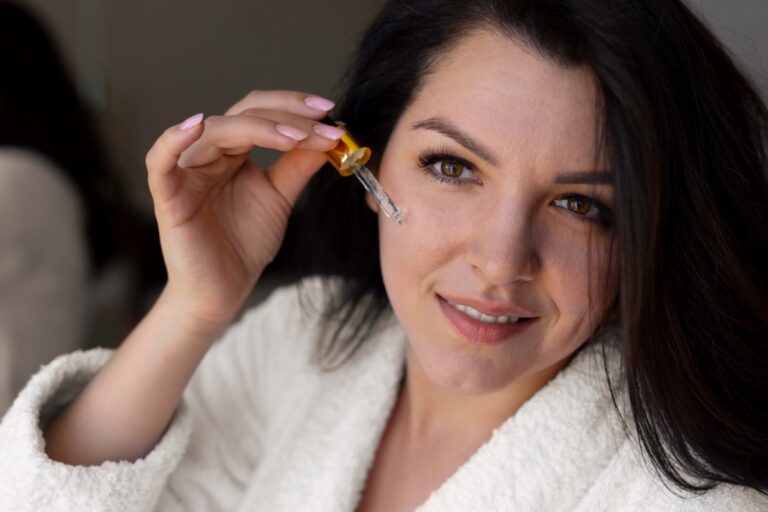Your skin doesn’t stay the same all year—and your routine shouldn’t either. Cold air, heat, humidity, and wind all have different effects on how your skin looks and feels. One season your face might feel tight and dry; the next, it’s oily and breaking out. That’s not bad luck—it’s just your skin reacting to its environment.
Most people stick to the same products year-round, but that’s like wearing the same clothes in summer and winter. It doesn’t work. Just like your wardrobe, your skincare needs to shift with the seasons.
So read on. This guide walks you through how to care for your skin in spring, summer, fall, and winter—without overcomplicating things. Whether you’re dealing with dry patches or sun damage, we’ll show you exactly how to adjust your products and habits to keep your skin calm, healthy, and glowing all year long.
Table of Contents
Why Skin Reacts to Seasonal Changes
Your skin is always trying to stay balanced, but the weather keeps shifting the rules.
In cold months, the air gets dry—outside and inside. That pulls moisture out of your skin and leaves it feeling rough or tight. You might even notice flakiness or redness. The colder it gets, the harder it is for your skin to stay soft and calm.
Then comes summer. Heat and humidity make your skin produce more oil. That can lead to breakouts or clogged pores, especially if you’re sweating more or using sunscreen every day.
Spring and fall bring their own challenges. One day is warm, the next is chilly. These quick changes can confuse your skin and make it more sensitive. Pollen in the spring or windy days in the fall can also irritate your face if your skin is already reactive.
And don’t forget the sun. UV rays hit your skin all year long, not just in summer. Even on cloudy or snowy days, your skin takes in that light, which adds up over time and can cause spots, dryness, or early signs of aging.
So here’s the deal: your skin isn’t doing anything wrong—it’s adjusting. The best thing you can do is help it along by tweaking your routine as the weather shifts. Let’s break it down by season and show you exactly what your skin needs next.
Spring Skincare: Refresh and Rebalance
Spring is when your skin starts to recover from the dry, harsh winter, but it doesn’t bounce back on its own. This is the time to clean up your routine, shed what’s not working, and make space for lighter, fresher care.
Repair the Winter Damage
After months of cold and indoor heating, your skin is likely dry, dull, or flaky. Start by using a gentle exfoliator once or twice a week. This helps clear away dead skin cells and makes your moisturizer work better.
Switch out heavy creams for something lighter but still hydrating, like a gel moisturizer or lotion with ingredients like hyaluronic acid or glycerin. These keep your skin soft without feeling greasy.
Handle Spring Allergies and Irritation
Spring comes with pollen, which can trigger breakouts, redness, or itchiness, especially if you touch your face more often. Cleanse your skin daily with something mild and fragrance-free to avoid buildup from allergens or sweat.
Look for products with calming ingredients like aloe, green tea, or centella. These soothe the skin without clogging pores or causing more reactions.
Change Up Your Products
You don’t need a whole new shelf. Just a few swaps help your skin feel fresh again.
- Cleanser: Go from creamy to gel or foam, especially if your skin feels oily.
- Moisturizer: Use a light, fast-absorbing formula during the day, and save thicker ones for bedtime if needed.
- SPF: Sun is stronger now. Use sunscreen daily, even when it’s cloudy.
Keep It Simple
Spring skincare isn’t about doing more—it’s about doing what works. Clear out old, expired products. Stick to what your skin actually needs: cleansing, hydrating, and protecting.
Now that your skin is waking up, it’s time to get ready for summer—where the heat and sun bring their own challenges. Let’s look at how to keep your glow going when the temperature rises.
Summer Skincare: Defend and Hydrate
Summer brings heat, sweat, and sun and your skin feels all of it. This season is about protection, oil control, and staying cool without drying out your skin.
Use Sunscreen Every Day—No Exceptions
UV rays are stronger now, and they don’t just cause sunburn. They break down collagen, darken spots, and speed up signs of aging. Use a broad-spectrum sunscreen with SPF 30 or higher every morning. Reapply every two hours if you’re outside.
Choose something lightweight and non-greasy, especially if you’re prone to breakouts. Gel-based, mineral, or water-resistant formulas are great for oily or acne-prone skin.
Control Oil Without Stripping
Sweat and extra oil can make skin feel dirty quickly, but don’t go overboard. Washing too often or using harsh cleansers can cause your skin to produce even more oil.
Stick to a gentle cleanser in the morning and night. If your face gets shiny mid-day, try blotting papers or a splash of cool water—skip the scrubs and astringents.
Keep Hydration Light and Consistent
Just because it’s hot doesn’t mean your skin needs less moisture—it still needs balance. Use a light moisturizer that hydrates without clogging your pores. Look for ingredients like aloe, hyaluronic acid, or squalane.
Face mists can help if your skin feels tight or irritated after sun exposure. Keep one in the fridge for a quick cool-down.
Support Your Skin With Antioxidants
Sunlight creates free radicals that damage your skin over time. Using a Vitamin C serum in the morning (under your sunscreen) helps defend against that damage and keeps your skin looking brighter and more even.
Make Small Tweaks That Add Up
- Skip heavy makeup when it’s hot out—clogged pores are harder to clean later.
- Avoid heavy oils or thick night creams unless your skin really needs it.
- Wear a hat or sunglasses—they help protect your face just as much as SPF.
Now that your skin has survived the sun, it’s time to repair, reset, and prep for cooler air. Let’s move into fall and focus on restoring balance after a long summer.
Fall Skincare: Strengthen and Rebuild
Fall is the season to undo summer damage and get your skin ready for colder, drier air. It’s a transition phase, and your skincare should reflect that.
Start Repairing Sun Damage
After a long summer, you may notice dark spots, uneven tone, or rough patches. Add products with ingredients like niacinamide, Vitamin C, or gentle exfoliants (like lactic acid) to brighten and smooth things out—without irritating your skin.
Go easy. Start slow, especially if you’re introducing acids or serums. Overdoing it now can cause dryness before winter even hits.
Switch to a Richer Moisturizer
As the air turns cooler and drier, lightweight summer lotions might not be enough. Look for a moisturizer with ceramides, peptides, or even a bit of shea butter. These help strengthen your skin barrier and lock in moisture.
You don’t need to go straight to heavy creams yet—just something with a little more cushion than what you used in summer.
Add Layers Without Overcomplicating
Fall is a good time to get back to layering. A simple routine might look like this:
- Cleanser (gentle, hydrating)
- Toner or mist (alcohol-free)
- Serum (brightening or calming)
- Moisturizer (creamy, not greasy)
- SPF in the morning
These small layers give your skin what it needs, without piling on too much.
Don’t Ditch SPF Yet
The sun might feel weaker, but UV rays still reach your skin, even on cloudy, cool days. Keep wearing sunscreen daily. Choose one with added moisture if your skin starts to feel dry.
Avoid Rushing Into Heavy Products
One common mistake: jumping too fast into winter-level creams and exfoliants. Give your skin time to adjust. Too much change too quickly can cause breakouts, flakes, or irritation.
Now that you’ve helped your skin recover and adjust, it’s time to face winter, the toughest season for keeping skin calm and comfortable. Let’s explore how to stay moisturized and protected when the cold really kicks in.
Winter Skincare: Nourish and Protect
Winter is tough on skin. Cold wind, dry air, and indoor heat all pull moisture from your face, leaving it dry, dull, or even cracked. This is the season to focus on comfort, moisture, and protection.
Moisturize More—and Smarter
Your skin loses water fast in winter, so switch to a thicker, cream-based moisturizer. Look for ingredients like ceramides, shea butter, or squalane. These help seal in hydration and keep your skin barrier strong.
Apply right after washing your face, while your skin is still a little damp. This helps trap the water before it evaporates.
Use a Gentle, Hydrating Cleanser
Foaming cleansers or strong face washes can strip your skin in cold weather. Switch to a creamy or oil-based cleanser that removes dirt without drying you out.
If your face feels tight after washing, your cleanser is too harsh.
Watch Out for Hot Showers
Hot water might feel great, but it dries your skin out fast. Keep showers warm, not hot, and try not to stay in them for too long. Use a body moisturizer right after drying off to help seal in moisture.
Protect Your Lips and Hands
Lips and hands are especially vulnerable in winter, as they are exposed and thin-skinned. Keep lip balm and hand cream with you and use them often, especially after washing hands or going outside.
Look for balm, not just gloss, for lips. Gloss alone won’t protect you from cold or wind.
Don’t Skip SPF
Yes, even in winter. UV rays still hit your skin, and snow can reflect them. If you’re outside during the day, especially if it’s bright or snow,y apply sunscreen like you would in spring.
Use a Humidifier Indoors
Heating systems dry out the air in your home. A small humidifier in your bedroom or workspace helps keep moisture in the air, which helps keep your skin calm and hydrated overnight.
How to Build a Year-Round Skincare Routine
Skincare doesn’t need to be complicated. What matters is consistency and small seasonal adjustments. The goal is to build a basic routine that works all year—then tweak it when the weather changes.
Stick to the Basics That Always Work
A solid skincare routine has three non-negotiables:
- Cleanser – Use something gentle that removes dirt without drying you out. Gel, cream, or foam—pick what feels right for your skin type.
- Moisturizer – Always use one. In summer, go lighter. In winter, go richer. Just keep your skin hydrated.
- Sunscreen (SPF 30 or higher) – Wear it every day. Indoors, outdoors, sunny, or cloudy—UV rays don’t care.
These three steps cover what your skin needs most: to stay clean, protected, and hydrated.
Adjust With the Seasons, Not the Trends
Instead of buying every new product, adjust one or two things as the weather shifts:
- Spring: Exfoliate gently. Swap heavy creams for lighter hydration.
- Summer: Focus on oil control and reapply sunscreen often.
- Fall: Add moisture and begin repairing sun damage.
- Winter: Use thicker creams, calming ingredients, and protect from dryness.
No need to overhaul your routine—just change what your skin actually needs at the time.
Don’t Layer Too Much
More products don’t mean better skin. Stick to a few steps that work. If you add something new, like a serum or exfoliant, give it time before introducing anything else.
Listen to Your Skin
Dry? Add moisture. Breaking out? Simplify your routine. Red or itchy? Drop anything with fragrance or actives. Your skin tells you what’s wrong—you just have to notice and respond.
Adjust With Travel and Climate Changes
New environments can mess with your skin—different water, air, and temperatures all matter. Pack a small set of products you trust, and keep it simple. If you’re flying, use a thicker moisturizer or face mist to combat cabin air. In dry or hot places, step up your SPF and hydration.
Bonus Tips for All Seasons
Some habits support healthy skin no matter the weather. These small things can make a big difference year-round, especially when your routine stays consistent.
Stay Hydrated From the Inside Out
Drinking enough water helps your skin stay smooth, plump, and less likely to dry out. It won’t fix everything, but when your body is hydrated, your skin has a better shot at staying balanced.
Eat Seasonal Foods That Support Skin Health
Fresh fruits and vegetables are packed with skin-friendly nutrients like Vitamin C, E, and antioxidants. Think berries in summer, leafy greens in spring, squashes in fall, and citrus in winter. Eating what’s in season also gives your skin what it needs at the right time.
Conclusion
Your skin doesn’t need a 10-step routine. It needs attention. Paying closer attention to how your skin responds to the seasons, the air, and your habits can go further than any trending product.
The real goal isn’t perfect skin. It’s healthy, responsive skin that feels good to live in.
So instead of chasing trends or copying someone else’s routine, focus on building habits that move with your life. Drink water, protect your face, switch things up when the weather shifts—and above all, be consistent.
Start simple. Stick with what works. Adjust as needed. Your skin already knows what it’s doing. You’re just helping it stay on track.



